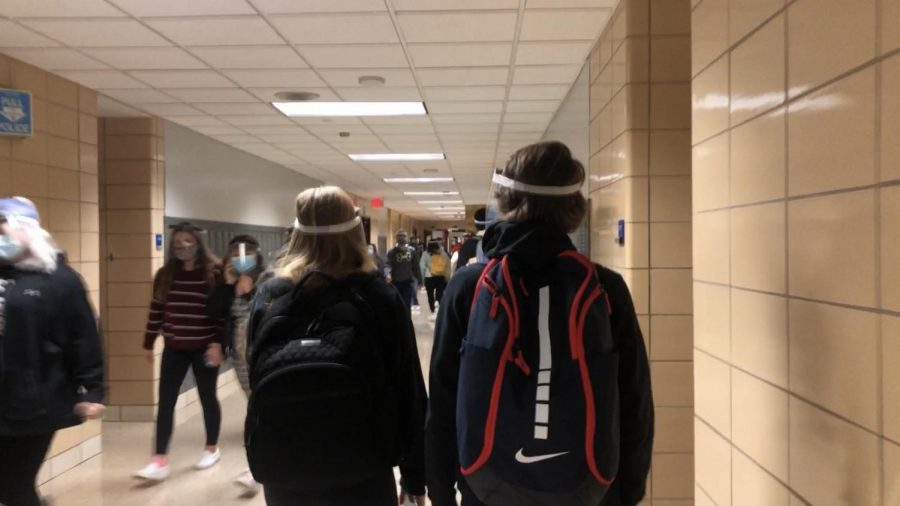First week of modified hybrid schedule raises mixed reactions
New safety protocols require face masks and face shields when walking in the hallways.
Beginning on Oct. 19, 70% of students and staff returned to campus under the modified hybrid schedule. As the schedule introduced the simultaneous teaching of in-person and remote students, the reactions elicited have reflected criticisms and praise alike.
From a learning standpoint, the modified-hybrid approach provides a return to a setting more similar to normal schooling. For many of those students that have returned to the classroom, the hybrid model creates a more engaging environment, as voiced by senior Mary Davenport.
“I think I learn better in hybrid because of the social interaction, specifically with my classmates. It has been much easier for me to communicate with classmates, allowing for me to develop a deeper understanding of [concepts],” Davenport said.
Physics teacher Stephen Zownorega shared a similar viewpoint, noting a preference for the real-time discourse that the modified hybrid model allows for, an aspect of learning that has grown sparse since remote-learning began.
“Hybrid, for sure, is way better. I felt, from the discussions that we had last class, ‘oh my goodness, I heard students talking about something,’ I was able to address it,” Zownorega said.
However, the hybrid model has also come with its share of challenges, especially for teachers now as they find ways to effectively teach and address all of their students. Zownorega explains some of the difficulties that he had as he taught the in-person and remote-learning group concurrently.
“I think it’s [difficult] just trying to maintain a similar experience for both parties. My attention is going to be split now — before it used to always be on the screen. And now, like today in class, I felt like I was looking a lot more at the students in the class because they were in front of me. There were moments where I was like, ‘oh, shoot, I need to make sure that I check in with the people on the zoom call,’” Zownorega said.
Senior Domani Sharkey, who decided to opt-out of the hybrid schedule, too has noticed the division of attention that teachers and students alike now experience.
“It’s not too bad, but I’ve definitely noticed that now the attention of my teachers seems to be more divided. You get the feeling that they’re bouncing back and forth, which is not their fault of course, but makes it more difficult to get your questions answered,” Sharkey said.
Other concerns raised had more to do with the classroom setting itself. Sophomore Levin Kandakudy highlighted an issue of inconsistency that he noticed since beginning hybrid learning at the beginning of the week.
“Sometimes hybrid feels strange. One class you could have two students and another with ten,” Kandakudy said.
Kandakudy continued on to address the matter of the efficacy of the new schedule attached to the modified-hybrid plan.
“Sometimes classes feel like they’re dragging on and I know a lot of people just don’t see the point of doing hybrid when it’s only four classes a week,” Kandakudy said.
Davenport shared the same opinion, expressing that the modified-hybrid schedule doesn’t create enough time per class to build peer and teacher relationships.
“We’re only seeing each class in person one time these first two weeks. If I could change one thing, it would be for the opportunity to see my classmates and teachers in any given class more than what is scheduled,” Davenport said.
Nevertheless, hybrid schooling has demonstrated its fair share of benefits. Davenport emphasized the importance of the socialization that hybrid allows for.
“I think that the classroom setting is less awkward than the remote setting because we used to spend all of our time in the classroom so it is nothing too out of the ordinary. Many people who are not on a sports team may prefer hybrid because they have been without socialization,” Davenport said.
The concern remains of the sustainability of modified-hybrid learning as DuPage County transmission levels remain in substantial. Zownorega expresses that, regardless of how long the modified-hybrid schedule will stay in place, it serves as a crucial transitional element as plans to return to school at some point are discussed.
“Even if we go out of school, sooner or later we’re going to have to do some sort of schooling when we get back to a moderate level or whatever the Illinois Department of Health tells us. In January, in February, in March, we’re going to have to be finding some way to get back into the classroom. There has to be a transition that has to occur, so [the modified-hybrid schedule] is good to practice,” Zownorega said.
As of now, the modified-hybrid schedule will remain in place through the end of the semester, but is subject to change as the district monitors the spread of the coronavirus alongside the DuPage County Health Department.


